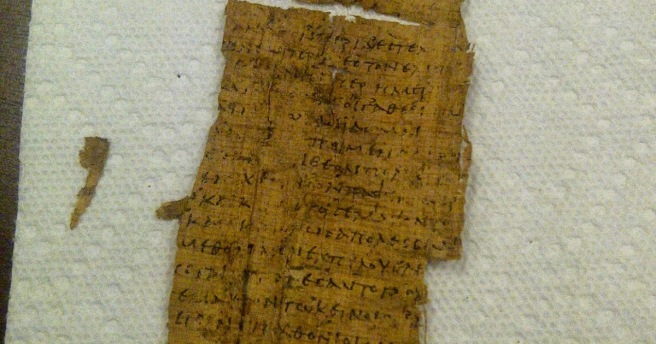
In a mummy mask. Don’t look at me like that, I just report what I read on the Web very quickly while watching the television and eating second lunch.
But what did you expect—a Spider-Man mask? But who knew from the Marvel universe back then? It was all DC stuff. So come Halloween you went trick-or-treating as a mummy, maybe a disgraced senator, a leper, occasionally Aquaman.
At present, the oldest surviving copies of the gospel texts date to the second century (the years 101 to 200).
This first-century gospel fragment was written on a sheet of papyrus that was later reused to create a mask that was worn by a mummy. Although the mummies of Egyptian pharaohs wore masks made of gold, ordinary people had to settle for masks made out of papyrus (or linen), paint and glue. Given how expensive papyrus was, people often had to reuse sheets that already had writing on them. …
[Professor of New Testament Craig] Evans said that the only reason he can talk about the first-century gospel before it is published is because a member of the team leaked some of the information in 2012. Evans was careful to say that he is not telling Live Science anything about the first-century gospel that hasn’t already been leaked online.
Soon after the 2012 leak, speculation surrounded the methods that the scholars used to figure out the gospel’s age.
Evans says that the text was dated through a combination of carbon-14 dating, studying the handwriting on the fragment and studying the other documents found along with the gospel. These considerations led the researchers to conclude that the fragment was written before the year 90. With the nondisclosure agreement in place, Evans said that he can’t say much more about the text’s date until the papyrus is published.
Will this Mark have the controversial ending, chapter 16, verses 9–20, which compels idiots to manhandle snakes in the hopes of proving they’re really saved to people who wish they’d just get a real job? Or will it have other material not found in our Bibles, perhaps scenes of the Apostles at the Daytona 500? (Which I’d think would call the whole carbon-14 business into question.)
I eagerly await the entire thing being misrepresented and blown completely out of proportion by the mainstream media.
ADDITIONAL THOUGHTS: So Mark has traditionally been regarded by scholars as the oldest of the gospels, the only one composed before AD 70—that is, before the destruction of the Second Temple. So a fragment pre-90 is not earth shattering unless there is a discrepancy between that text and the one we see reflected in our contemporary Bibles. Now a fragment of John that is pre-90 would be something to see, given that John is now thought to have been written in the early to mid-90s. (It had once been believed to have been written in the second century, but that idea has been discredited.) Of course, J.A.T. Robinson, a liberal Anglican bishop, wrote an infamous book published in 1976 called Redating the New Testament in which he claimed that the entire New Testament was finished before AD 70. The question remains whether he was merely intending to be deliberately provocative; there is no question that virtually no NT scholar agrees with this conclusion.
So how precise is this dating? Can you refine the process such that you get to within a couple of years? Or is the best you can hope for a couple of decades? When dealing with the New Testament, that’s all the difference in the world. Entire careers can be made or broken by such discrepancies. If that Markan fragment is definitely pre-90, how pre-90 is it? 85? 75? 65? Could it have been composed before Paul’s letters, which are regarded as the earliest NT documents we have? If so, would Paul have known about it? Is that even an answerable question?
This should be interesting…

You must be logged in to post a comment.